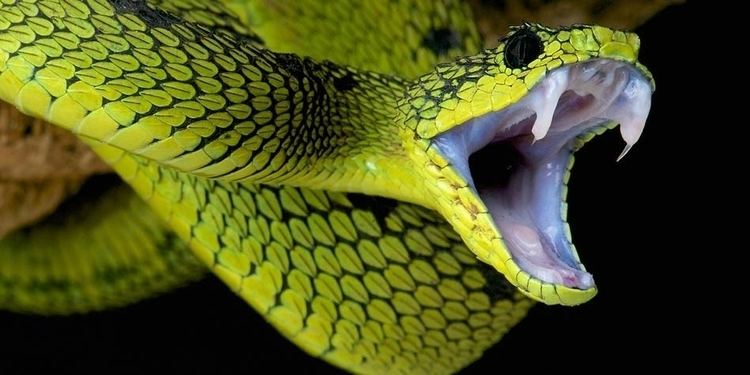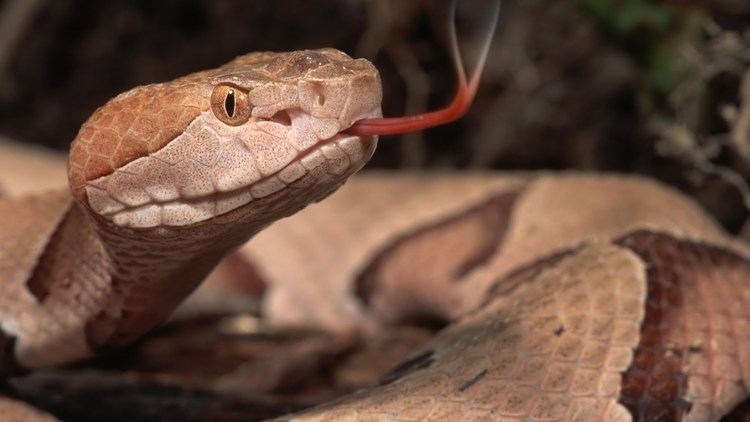Clutch size Causus rhombeatus: 24 | ||
 | ||
Speed Causus rhombeatus: 3.3 km/h Hibernation period Horned Viper: 61 – 183 days Length Horned Viper: 50 – 70 cm, Causus rhombeatus: 10 – 12 cm Representative species King cobra, Many‑banded krait, Inland taipan, Coastal taipan, Tiger snake | ||
Venomous snakes are species of the suborder Serpentes that are capable of producing venom, which is used primarily for immobilizing prey and defense mostly via mechanical injection by fangs. Common venomous snakes include the families Elapidae, Viperidae, Atractaspididae, and some of the Colubridae. The toxicity of them is mainly indicated by murine LD50, while multiple factors are considered to judge their potential danger to humans.
Contents
- Top 10 most venomous snakes in the world
- Evolution
- Taxonomy
- Terminology
- Toxicity issues
- Other factors
- References

Top 10 most venomous snakes in the world
Evolution

The evolutionary history of venomous snakes can be traced back to as far as 25 million years ago. Snake venom is actually modified saliva used for prey immobilization and self-defense and is usually delivered through highly specialized teeth, hollow fangs, directly into the bloodstream or tissue of the target. Evidence has recently been presented for the Toxicofera hypothesis, but venom was present (in small amounts) in the ancestors of all snakes (as well as several lizard families) as "toxic saliva" and evolved to extremes in those snake families normally classified as venomous by parallel evolution. The Toxicofera hypothesis further implies that "nonvenomous" snake lineages have either lost the ability to produce venom (but may still have lingering venom pseudogenes), or actually do produce venom in small quantities, likely sufficient to help capture small prey but causing no harm to humans when bitten.
Taxonomy
There is not a single or special taxonomic group for venomous snakes which comprise species from different families. This has been interpreted to mean venom in snakes originated more than once as the result of convergent evolution. Around a quarter of all snake species are identified as being venomous.
Terminology
Venomous snakes are often said to be poisonous, but poison and venom are not the same thing. Poisons must be ingested, inhaled or absorbed, while venom must be injected into the body by mechanical means. It is, for example, harmless to drink snake venom as long as there are no lacerations inside the mouth or digestive tract. The two exceptions are: the Rhabdophis keelback snakes have glands that secrete poison they ingest from eating poisonous toads, and similarly, certain garter snakes from Oregon retain toxins in their livers from ingesting rough-skinned newts. This ability to sequester toxins and store them for defense renders these certain snakes both poisonous and venomous.
Toxicity issues
LD50, mostly on rodents, is a common indicator of snakes' toxicity with a smaller resultant value indicating a higher level of toxicity. There have been numerous studies on snake venom with a variability of potency estimates. There are four methods in which the LD50 test is conducted, which are injections to subcutis (SC), vein (IV), muscle (IM or IC), and peritoneum (IP). The former (SC) is most applicable to actual bites as only vipers with large fangs, such as large Bitis, Bothrops, Crotalus or Daboia specimens, would be able to deliver a bite that is truly intramuscular, and snakebites rarely cause IV envenomation. Testing using dry venom mixed with 0.1% bovine serum albumin in saline, gives more consistent results than just saline alone.
Belcher's sea snake (Hydrophis belcheri), which many times is mistakenly called the hook-nosed sea snake (Enhydrina schistosa), has been erroneously popularized as the most venomous snake in the world, due to Ernst and Zug's published book "Snakes in Question: The Smithsonian Answer Book" from 1996. Prominent venom expert Associate Professor Bryan Grieg Fry has clarified the error: "The hook nosed myth was due to a fundamental error in a book called 'Snakes in question'. In there, all the toxicity testing results were lumped in together, regardless of the mode of testing (e.g. subcutaneous vs. intramuscular vs intravenous vs intraperitoneal). As the mode can influence the relative number, venoms can only be compared within a mode. Otherwise, it's apples and rocks.". Belcher's sea snake's actual LD50 (recorded only intramuscularly) is 0.24 mg/kg and 0.155 mg/kg,. Studies on mice and human cardiac cell culture shows that venom of the inland taipan, drop by drop, is the most toxic among all snakes.
Other factors
Toxicity of snake venom (based on laboratory tests conducted on Mice) is sometimes used to gauge the extent of their danger to humans, but this is not enough. Many venomous snakes are specialized predators whose venom may be adapted specifically to incapacitate their preferred prey. A number of other factors are also critical in determining the potential hazard of any given venomous snake to humans, including their distribution and behavior. For example, while the inland taipan is regarded as the world's most venomous snake based on LD50 tests on Mice, it is a shy species and rarely strikes, and has not caused any known human fatalities. On the other hand, India's Big Four (Indian Cobra, Common Krait, Russell's Viper, and Saw-Scaled Viper), while less venomous than the inland taipan, are found in closer proximity to human settlements and are more confrontational, thus leading to more deaths from snakebite. In addition, some species, such as the black mamba and coastal taipan, occasionally show some aggression, generally when alarmed or in self-defence, and then may deliver fatal doses of venom, resulting in high human mortality rates.
